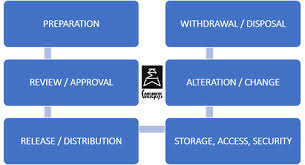
Document Control Best Practices
Effective document control is essential for organizations to maintain accuracy, consistency, and compliance in their operations. By implementing best practices in document control, companies can ensure that their documents are properly managed, secured, and easily accessible. Here are some key best practices to consider:
Establish a Document Control Policy
Start by creating a comprehensive document control policy that outlines the procedures for creating, revising, approving, and storing documents. This policy should define roles and responsibilities within the organization regarding document management.
Standardize Document Naming Conventions
Develop a consistent naming convention for documents to ensure easy identification and retrieval. Include relevant information such as document type, version number, date, and department to facilitate organization and searchability.
Implement Version Control
Use version control mechanisms to track changes made to documents over time. Maintain a clear record of revisions, approvals, and updates to ensure that the most current version of a document is always available.
Secure Document Access
Protect sensitive documents by restricting access based on user roles and permissions. Implement encryption, password protection, or other security measures to prevent unauthorized viewing or editing of confidential information.
Backup and Disaster Recovery
Regularly backup all documents stored in electronic formats to prevent data loss in case of system failures or disasters. Have a robust disaster recovery plan in place to quickly restore access to critical documents in emergency situations.
Conduct Regular Audits
Schedule periodic audits of your document control processes to identify any gaps or areas for improvement. Ensure compliance with regulatory requirements and industry standards through thorough documentation reviews.
Provide Training and Support
Offer training programs for employees on proper document management practices and tools. Provide ongoing support and guidance to help staff understand the importance of following document control procedures.
By following these document control best practices, organizations can streamline their operations, reduce errors, enhance collaboration, and mitigate risks associated with poor document management. Investing time and resources in effective document control will ultimately lead to improved efficiency and productivity across the organization.
Mastering Document Control: Essential Best Practices for Policy, Naming Conventions, Version Management, and Security
- What is document control and why is it important?
- How can I establish an effective document control policy?
- What are the key components of a document naming convention?
- Why is version control important in document management?
- How can organizations ensure secure access to sensitive documents?
What is document control and why is it important?
Document control refers to the systematic management of documents throughout their lifecycle, including creation, revision, approval, distribution, and retention. It is essential for organizations to maintain document control to ensure accuracy, consistency, compliance, and efficiency in their operations. Proper document control practices help companies avoid errors, reduce risks of miscommunication or data loss, improve decision-making processes, enhance collaboration among team members, and ensure regulatory compliance. By implementing effective document control measures, businesses can streamline their workflows, safeguard sensitive information, and maintain a structured approach to document management that supports organizational goals and objectives.
How can I establish an effective document control policy?
Establishing an effective document control policy is crucial for ensuring consistency and compliance within an organization’s document management processes. To create a robust policy, start by defining clear procedures for document creation, revision, approval, and storage. Assign roles and responsibilities to individuals within the organization to oversee these processes and ensure accountability. Standardize naming conventions and version control mechanisms to maintain organized and up-to-date documentation. Consider factors such as document access permissions, security measures, backup protocols, and regular audits to strengthen the policy’s effectiveness. Providing adequate training and support to employees on the importance of following document control procedures is also essential for successful policy implementation. By establishing a comprehensive document control policy, organizations can enhance efficiency, accuracy, and regulatory adherence in their document management practices.
What are the key components of a document naming convention?
A well-defined document naming convention is crucial for efficient document control practices. The key components of a document naming convention typically include relevant information such as document type, version number, date, and department. By incorporating these elements into the file names, organizations can ensure consistency, clarity, and easy retrieval of documents. A standardized naming convention helps users quickly identify the purpose and context of each document, facilitating organized storage and streamlined access within the document management system.
Why is version control important in document management?
Version control is crucial in document management because it ensures the integrity and accuracy of documents throughout their lifecycle. By maintaining a clear record of changes, revisions, and updates to a document, version control allows users to track the evolution of a file and easily identify the most current version. This helps prevent errors, inconsistencies, and confusion that can arise from working on outdated or incorrect versions of a document. Additionally, version control promotes collaboration by enabling multiple users to work on a document simultaneously while ensuring that changes are properly recorded and tracked. Overall, version control enhances efficiency, transparency, and accountability in document management processes, making it an essential component of effective document control best practices.
How can organizations ensure secure access to sensitive documents?
Ensuring secure access to sensitive documents is a critical aspect of document control best practices for organizations. To achieve this, companies can implement robust security measures such as role-based access controls, encryption, password protection, and user authentication protocols. By restricting document access based on user roles and permissions, organizations can prevent unauthorized viewing or editing of confidential information. Additionally, regular audits and monitoring of document access logs can help identify any suspicious activities and ensure compliance with data security regulations. By prioritizing secure document access procedures, organizations can safeguard their sensitive information from unauthorized disclosure or misuse.
